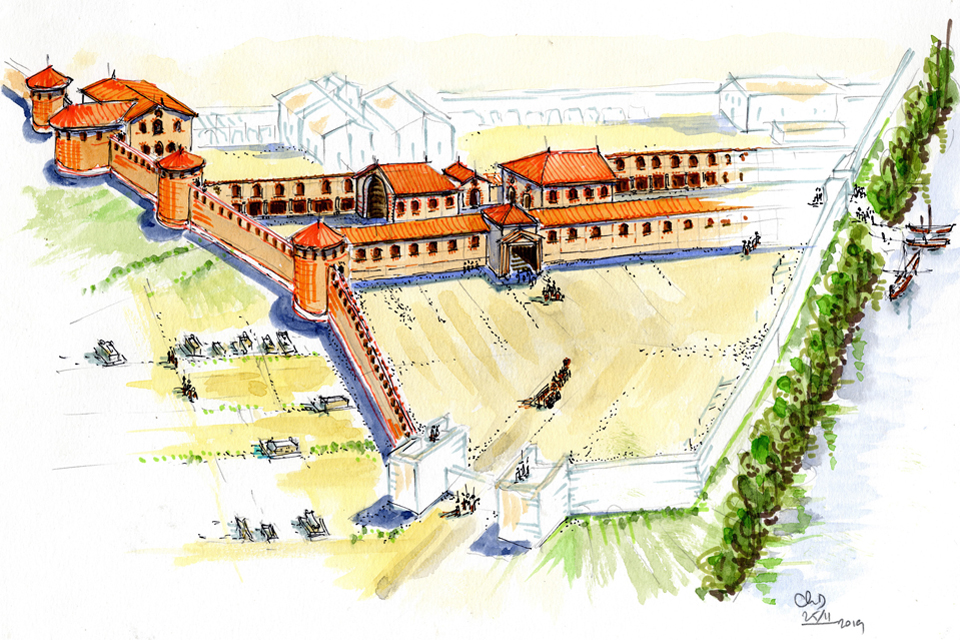Of all the barbarians entering the Roman Empire in Late Antiquity, the Visigoths were among the first to forge a successor-kingdom. Scholars disagree as to the early nature of this fledgeling polity, but the result is clear: the centre of the first barbarian kingdom in the 5th century came to be located at Toulouse.
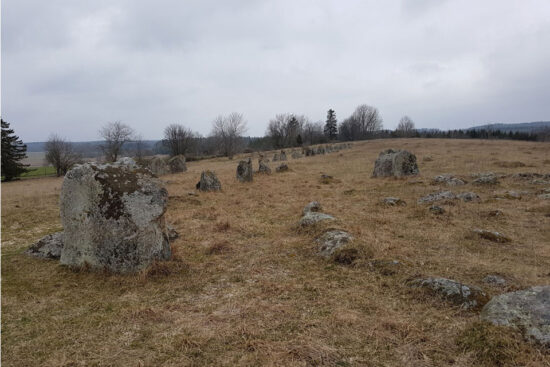
In AD 376, two large groups of people – The Tervingi and the Greutungi – gathered on the northern banks of the Danube near Silistra (ancient Dorostorum) asking for asylum among the Romans. We are well-informed about the following events through the writings of Ammianus Marcellinus (c. 330, died c. 391 – 400) and the Greek historian, Eunapius (as mediated by Zosimus c. 500). All characterised these two groups as belonging to the people of the Goths, about whom Jordanes (†552) later wrote a story somehow based on the now lost writings by Cassiodorus (ca. 485-580).
According to Jordanes – who considered himself a Goth – the Goths were “said to have come forth long ago” from the “island of Scandza”, that is “Scandinavia”. This story of origin tells us that at least in the mid-sixth century, the “Goths” had a well-formulated idea of their identity, who they were and from where they derived.
And yet, among 20th-century historians, it became unfashionable to imagine that such groups of people might have a well-worked idea of their ethnic or tribal ancestry, or even a sense of identity, which might exist before the establishment of their successor-kingdoms in the 5th and 6th century. Rather, the dogma became that their identification as “Goths”, “Vandals”, “Sueves” etc. derived from their establishment under these names as recognised polities in the 5th century.
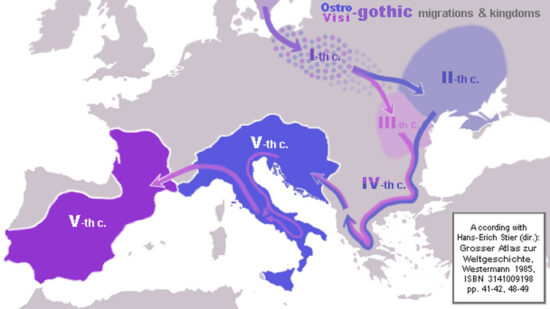
However, Roman labelling pointing them out as “peoples” or “tribes” reflected an old practice, already well established in the writings of Caesar (100-44 BC), Tacitus (AD 56 – 120) and Ptolemy (AD 100-170); later this practice was confirmed indirectly by scripture, which juggles with “tribes” and “peoples” in both the Old and the New Testament. There is no reason to believe that the idea of being an “identifiable” tribe or belonging to a specific one did not exist north and east of the limes in the early Roman Empire among the different groups of people, with which their imperial neighbours came in close contact during the Roman optimum and later.
The question remains, however, when did a distinct people come to be identified as Goths? And not least, when did they come to identify themselves as such? The first allusion may be found in Tacitus, who wrote about a people called Gutones or Gotones living near the Baltic. Ptolemy followed up on this by locating them at the mouth of the river Vistula in present-day Poland. Linguists are not in doubt that it was the same people, which later in the middle of the 3rd century lived on the Pontic Steppe, showing off a distinct material culture reminiscent of that dominating the Vistula region a hundred years earlier. From these new settlements to the north and east of the Lower Danube, these people – called Goths by the Romans – conducted numerous land-borne and sea-borne raids into the Roman Empire. Later, these raids turned into regular invasions followed by war. In the end, however, Rome abided, and a period of coexistence ruled from AD 300 – 375. At this point, the “Goths” was an established and by the Romans recognised group of people settled to the north of the Danube in present-day Bulgaria.
When did the Goths begin to talk about themselves as a “people”?
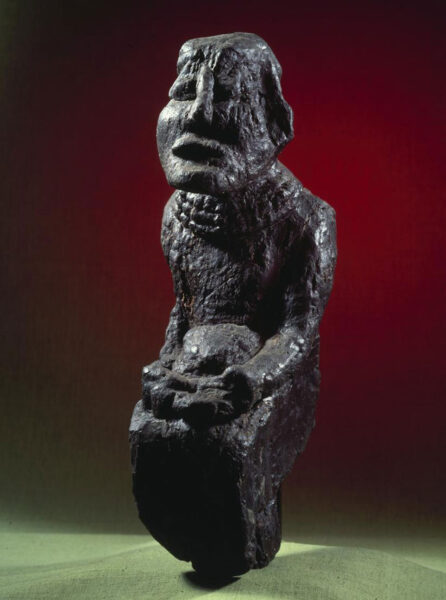
Recent studies[1]of Swedish place-names have demonstrated that the ethnonym was not just a label affixed by the Romans to the Goths. Rather, before they partially emigrated to the region around the Baltic, they must have identified themselves as *Gautoz with an origin in Östergötland and Västergötland. Here, place-names such as “Götevi”, “Götala” and “Götlunda” continue to indicate where the Iron-Age heathen cult-places of these “Goths” were located. While vi means “holy place”, and lunda a “holy grove”, al probably means “temple”. Also, part of these people may have identified themselves as *Gutaniz, corresponding to “Gutar” living on the Island of Gotland. There, inhabitants still call themselves “gutar”; we hear the echo of this in the personal name of the king, Alaric (AD 370-410), a man “rich in temple-good’s and favour”.
It has been suggested that the element Göt- or Gut- derived from a Proto-Germanic *geutan, a verbal stem meaning “to pour”; hence, the formation of such hydronyms as “Göta Älv”. Probably more significant, though, is the later by-name of Odin, “Gautr” or “Gauti”. The byname is preserved in old Icelandic literature, where he is called “Gautatýr” – literally the God of the Gautar”.
Whatever, the etymology of *Gautoz and *Gutaniz, it seems reasonable to acknowledge that the Roman and Greek historians and geographers did not invent this ethnonym. It must have been introduced to them by the people themselves. What this heritage meant to them and at different times in their migratory history is quite another matter.
The Goths

At some point, large segments of these “Goths”, named as Tervingi and Greutungi (see below for the etymology) migrated across the Baltic carrying with them their tribal names and language while settling at the Wistula River. Likely, these people were engaged in the very profitable trade with amber and skins leading to their gradual movement south along the ancient amber-route between the Baltic Sea and the Roman Empire. In the 3rd century, we meet them once more in the sources carrying out substantial raids and waging war on the Eastern Roman Empire (The Gothic Wars, AD 249 – 269). However, their formation of a later kingdom settled in the Garonne Valley at Toulouse has its roots in the events following AD 376.
However, were these later people Goths at all? And in what sense? The ethnonym, Visigoth, was probably first ”invented” by Cassiodorus (c. AD 485-585) in order to create a division of the two people of the Goths, the Visigoths and the Ostrogoths. Also, the barbarians who entered the Roman Empire in 376 were not only not called Goths, but the Tervingi and the Greutungi.
The main point to make here, though, is not about the suffixes, -inge or –ungi, (Proto-Scandinavian *-ingia, *-ungia), which means ”the people of”, that is ”belonging to” or ”coming from”. Place-names with these endings are introduced in parts of Scandinavia and the Eastern Germanic part of the European continent in the very first centuries of the new millenium. They were and are particularly frequent in the region around Mälaren and Vättern, in both Eastern and Western Götaland, a region which place-name studies show the “Goths” (somehow) considered their ancestral home. Rather the two prefixes, terv- and greut- deserves our attention.
“Terv” is likely a proto-Germanic alternation of *terw and *trew – from *trewa- (tree, wood) and *terwa- (tar). Greut is derived from Old Norse *grjót (gryt) meaning stone or rubble, Proto-Germanic *greutą (gritstone or sand)
Traditionally, these ethnonyms have been translated as “forest-people” and “shore-people”. The suffix “grjot” is well-known in place-names in Bohuslän, now a Swedish border region to the utmost east, which contains nothing but “shores”. Two of these places – Grössby and Grjotbyr (now Greby) – functioned as the major regional burial place, a religious cult-place and a “thing” from AD 200 – 500[2].
However, the most interesting characteristic of these two names is the construction of the ethnonym by the coupling of a physical topographic feature and the suffixes –ingi or –ungi. In a Scandinavian context, place-names from which such people were derived were topographic. Further south, such place-names were constructed by the coupling of the name of a person and his people. One must presume that such place-names were secondary to the tribal names.
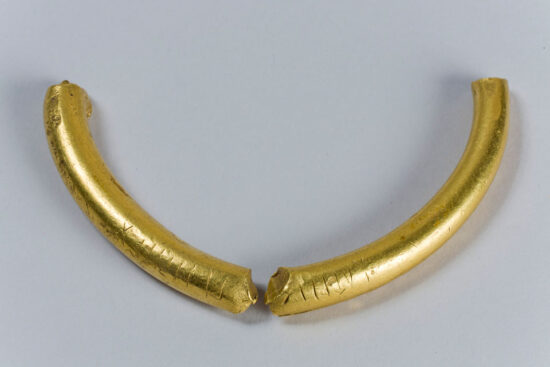
But were these people Goths at all? The answer may lie buried in a verse from a poem written by the western imperial court poet, Claudianus, who in AD 399 authored a nasty vilification of the eunuch Eutropius, who had been appointed consul by the eastern emperor. In this poem we read that: “Ostrogothis colitur mixtisque Gruthungis Pryx ager” (The Ostrogoths cultivate the land of Phrygia together with the Greutungi)[3]. It may also be assumed from the historian, who recounted the events in AD 375 -78, Ammianus Marcellinus. He writes specifically not just about the Goths, but about the “reliquas gentes” of the Goths[4], that is the different people (groupings or “tribes”) of the Goths. At least in these two contemporary sources, the two people called Tervingi and Greutungi were considered “Goths”.
The question remains, though, whether these people at this time thought of themselves as “Goths”?
Of this we get an inkling when considering the so-called Pietroasa treasure with its neck-ring and its Runic inscription “Gutani()o wi hailag”, – or transcribed as “Gutane ōþal Weih Hailag” – usually translated as “The Gothic heritage, sacred and blessed” or “The heritage bless the Goth as sacred”. It has been suggested that the inscription was more performative, and less descriptive. The majority, though, of the very early Runic inscriptions are descriptive indications of what an object is all about. The ring is the heritage, and it blesses the Goth (in dative). Likely, the ring was used to hang around the neck of the statue of a God of the Goths, perhaps Odin. Other similar rings have been found in Scandinavia (Tissø). Also, naked statuettes bearing torcs and from the 3rdand 4thcenturies are not uncommon in a Scandinavian context. Pertinent to this question may be the result of a technical exploration of the gold, which was used to manufacture the two rings in the hoard. They contain a copper concentration, which significantly differs from the other artefacts in the hoard. The rings were made of a less pure gold and should probably be dated earlier (the 3rdcentury) than the rest of the artefacts in the treasure (late 4thcentury). The rings also differ from these artefacts, which seem to represent a collection of gaudy “Gothic” kitsch.
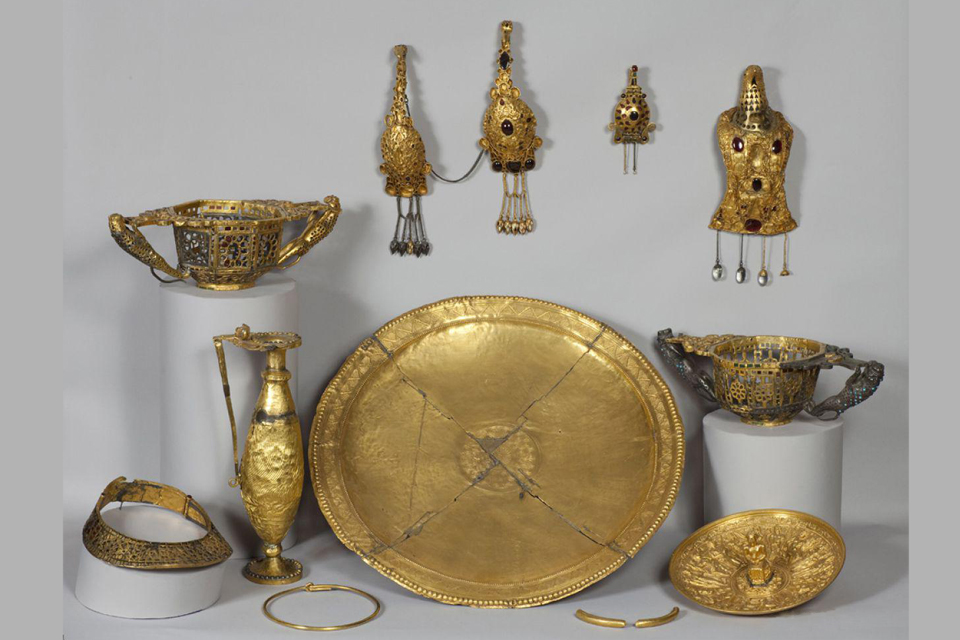
AD 376 – 411
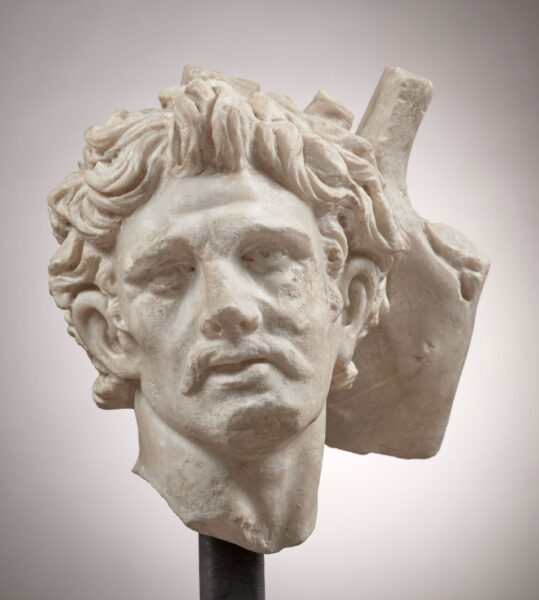
We may safely conclude that when the large group of barbarian warriors and panic-stricken refugees begged the Romans for admission to cross the Danube and enter the Roman territory, they did have a sense of themselves as “Goths”. According to the historians, only half of the people were at first allowed to cross and many died in the attempt to forge the river. Later, the rest crossed illegally.
A year later, and due to Roman bungling of these famished hordes, the Goths got their act together and waged war on a Roman army, mustering 30 – 40.000 imperial troops. Peter Heather has regarded this number inflated and claims that the size of the two armies were no more than 15.000 on each side. Based on this, he has estimated a total of 75.000 to a 100.000 migrants, arguing that groups of refugees usually number more males than females – the woman, the children and the elderly are left behind or die. On the other hand, Bernard S. Bachrach has estimated that the size of the fielded Barbarian army must have matched the Roman Army, which univocally mustered between 30-40.000 men. Usually an able-bodied warrior or male corresponds to a “family” of 4.5 persons, which means that the total group would amount to between 135–180.000 people (including dependents). Bachrach concludes that the total size of the group, which crossed the Danube may have numbered the 200.000 assessed by Eunapius[5].
Known as the Battle of Battle of Adrianople 378, the events concluded in a devastating defeat of the Roman Army and the death of the Emperor, Valens. Some historians consider these events as the watershed of the Western Roman Empire. The point of no return[6].
In the aftermath of the battle, the Goths settled as “foederati” – groups of migrants destined to supply war-bands and warriors – in more or less self-governing barbarian enclaves. In one of these, the Goth, Alaric (AD 370 – 410), grew up. In AD 392, he entered the Roman army. In the coming decade, Alaric would fight as a mercenary and military leader for the Romans; but he also acted as the supreme leader of a Gothic army pillaging in Eastern Europe until he invaded Italy in AD 402. In AD 408, Alaric ended up in front of the walls of Rome at which point he began his first siege. In AD 410 this culminated in the famous first sack of Rome.
Alaric, unfortunately, had only a little time left to enjoy the looted riches. Three days after the sack, he marched to the south to feed his army. Next year, as he was returning, he took ill and died at Consenza in Bruttium. According to legend, his men diverted the river and dug a grave in the riverbed, depositing some of his most precious spoils together with his body. Afterwards, the slaves, who knew the location of the grave, were executed. Since then, treasure-hunters including, of course, Himmler, sought to trace the fabled hoard. In the latest instalment of this adventure, a group of local politicians and scientists began a search using metal detectors, lidar-surveys etc. So far, no one has heard much about this project. Apparently, an undisclosed group of Italians and French treasure hunters are at the present seeking permits.
AD 411-418 – Hospitalitas or Pax?
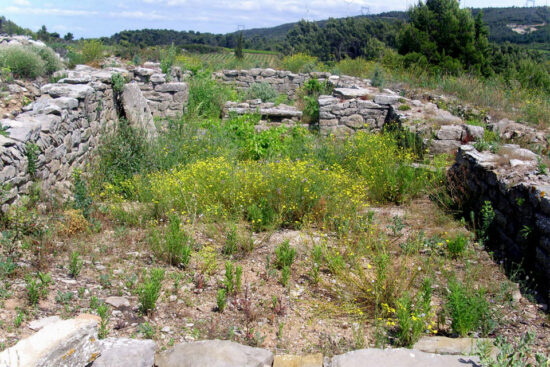
Next in line was Athaulf, brother of Alaric. In AD 412 he left Italy and entered southern Gaul, where he continued the looting and racketeering of his brother. In his company was a prominent hostage, the half-sister of the Roman Emperor Honorius, Galla Placidia. In AD 414, Athaulf married her in Narbonne. Later, she travelled with him and their son to Spain, where the son died, and Athaulf was killed in Barcelona in the imperial baths. After seven days, the murderer, too, was killed, and a Gothic aristocrat, Vallia, gained the upper hand. In AD 416–18 , this Vallia concluded a peace treaty with the later emperor, Constantius, in the long haul securing the Visigoths a permanent residence in Toulouse and Aquitaine; and de facto founding the new kingdom of the Visigoths.
Historians of Late Antiquity have heavily debated the character of this treatise. Was it a feudus – a flexible and temporary agreement between Rome and a large group of foederati, mercenaries (also called buccelarii)? Such agreements were well-known Roman instruments to get an army of mercenaries temporarily billeted. Thus, was it an arrangement whereby the Visigoths might be offered hospitalitas (billeting as part of tax-sharing), thus reducing them to a significant military presence quartered in urban and rural garrisons, where they would be paid in the form of “protection money” from “tax-farming”? Or was it rather a situation, where the Visigoths were considered veterans and accordingly offered pax, including land and victuals to get started as settled farmers? As had been the legal practice since the earliest settlements of veterans in colonies?
Since Walter Goffart[7]in 1980 published his book on “Barbarians and Romans” and the “Techniques of Accommodation”, historians from the Toronto School of History have viciously debated this question with representatives from The Vienna School of History; lately, voices from Oxford have also made their mark.
A careful perusal of the wordings of the very few relevant sources from ca. AD 450, which recorded the events in AD 417, reveals, however, that Goffart was “deeply mistaken”[8]. Involved, as he was, in his personal life-experience as a Belgian WW2-refugee with cosmopolitan roots, he approached the question from a very legalistic and pro-muliti-cultural point of perspective [9]. The following debate was both vicious and clamorous.
However, it has been painstakingly shown that the main evidence, which Goffart fielded, derived mostly from Italy. Further, we should note the close reading , which Hagith Sivan in 1987 carried out of the relevant texts. In her perusal of the notes in the chronicles by Prosper of Aquitaine ca. 450, Hydatius ca. 427-468, the Gallic Chroniclers ca. 452, and Marcellinus Comes, she found that all these chroniclers the word “pax” was used to describe, what was at stake. One of these authors (Prosper) more specifically wrote that not only did Constantius “make peace with Vallia”, he also gave him Aquitaine to inhabit[10]. Hydatius wrote that they were given “sedes in Aquitanica a Tolosa usque ad Oceanum”.[11]
The crucial hinge for a solid argument is the word “pax”, which we should not translate too blandly. Instead, we should note that Roman law, when applying this concept provided a precise legal basis for grants to veterans of vacant land together with a customary tax exemption. Part of such a grant was also victuals and money to successfully establish the veteran as a farmer. “Veteran’s privileges provided the ideal compromise whereby to ensure Gothic loyalty and pacify any landowners involved in the process”, Sivan wrote[12].
In this connection, it is worth noting two paragraphs in the later (Visigothic) Code of Euric from c. AD 470-80, which refer back to two rulings by Theoderic I (King of the Visigoths 418-51). During his reign, Theoderic had apparently underwritten the ancient boundaries and declared that no one should be allowed to state ancient claims about their “sortes”. The time-limit decreed by Euric, 50 years, brings us back to the very early years of the first Visigothic settlers. Moreover, we are told, which form these settlements took, sortes. Initially, the word “sors” referred to a form of divination, which involved the drawing of lots. But it also at some point in Late Antiquity came to be used as a metaphor for what had been allotted, namely land [13].
Likely, this is the reason why John Matthews[14] in his studies, translated “sortes” in the relevant paragraph with allotment. However, the correct translation must be “farm” or “peasant holding”; allotment gives a modern-day whiff of a small urban garden. Sortes later came to be the equivalent of a mansus, the medieval term for a farm. According to an edict of Constantine, later (AD 429-38) repeated in Codex Theodosianus (§ 7.20.8), a veteran at this point received a piece of land, a pair of oxen, 25 folles (bronze coins) and a 100 bushels (modii) of grain[15]; enough to tide over a family as well as provide seed for the next year. Likely, the land would be taken from agri deserti, of which the Roman emperor at this point in time had abundant. Whatever else a Visigothic veteran received in substantial support, we shall likely never know. But we may safely say, there was an ideal based on which the Romans negotiated the “pax” of the new settlers. Such a pax included a “lot of land”, money, and victuals to get the new settlement going. We may also presume that such “help” was paid for by the local Romans in the form of a surtax. It cost to let the barbarians settle. It may have felt comfortable at first, but once settled, the new people on the block set a new agenda.
In 2020, we may deem this academic debate moot. Most likely, some Visigoths received a substantial holding – either on state-owned and deserted land or expropriated from local Romans; others were left to eke out a livelihood as soldiers in local forts; others probably forced themselves upon local landowners, by force demanding “hospitium”. The reality is never quite as legalistic or neat as we may wish for. However, settle they did, and on land – whether on agri deserti (deserted land), caduca (forfeited land), or privatae (privately owned land). Later, the laws of Theoderic II and Euric expressly forbade the possibility of raising any questions as to the legality of these settlements or grants in their courts. Curiously, historians have argued that grants of land were not involved by reference to the fact that no major conflicts left their mark on the later history by marring the coexistence of Romans and Goths in the 5thcentury. However, the two paragraphs preserved in the fragments of Euric’s Code point to the opposite. Dispossessed Romans and Goths did try to remedy injustices concerning land; and were told that any legal claims referring back to the first wave of settlements, would not be heard.
Gothic Place-Names and Archaeological Finds in Aquitaine
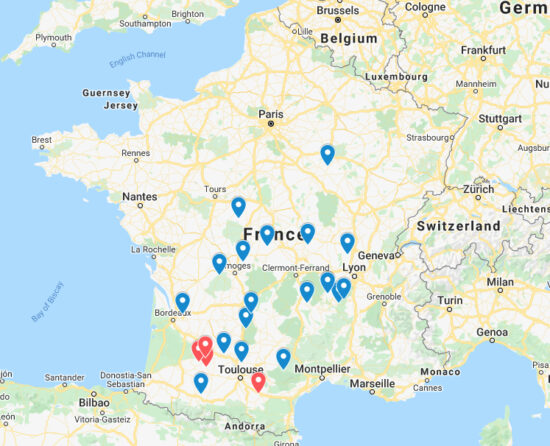
The best evidence of the hundred-year long sojourn of the Goths in Aquitaine may be found in the place-names witnessing to this history as they settled down[16].
One might think that place-names, which did involve the suffixes *-ingoz, *-ungoz (and its later development *–ia/*-ingia), which in Southern France turned into –ens, -enx, -encs, -eins, -an, -ans, or –enques, might supply the best evidence. In 1961, 29 such place-names were registered in Aquitaine. Later studies, however, ended up with only seven such place-names identified as representing Visigothic settlements[17]. The reason was, this particular type of place-names was productive for most of the first millennium. Hence, it is no longer possible to pinpoint them as “Visigothic”. They might as well just be undefined “Barbarian”(Frankish).
However, another group of place- names are more specific – those, which directly involve “Goth”, for instance, Villa Gothica or Gothorum Villa. Unfortunately, not even those place-names are univocal as Latin Gutus or Guttus, “bottle-neck” was a common metaphor for “stream”; and settlements were always located next to running water of some kind (compare to modern FR: “gouttière”, Eng: Gutter. Nevertheless, a handful of “Gothic” settlements have been identified in the region of Toulouse as Goudorest, in the modern form of Goudou, Goudour, Goudous, Goudout, Goudoux Goudourville, Goudon. Notice also the instances of Villegoudou, Villegours, Villegouge, Montgoudou, Montgour, La Gorvelle, Goise, Gouise, Gueuse, Gueses. Piegoudès, Goudeix, Goudesques (see map).
The map indicates that these places were located to the north and east of Toulouse, while a few instances of place-names involving personal names show a later presence in Septimania, the region, which the Visigoths succeeded in winning in the second half of the 5thcentury, when they pushed their realm from Toulouse to the south and east.
Material culture is notoriously difficult to use as evidence for the presence of a specific people in a specific location. Jewellery and weapons may be traded, or taken up and reused by anyone in new contexts. Such finds do not tell us precisely whether “Kilroy was here” or not. However, a recent survey of finds of East Germanic derivation – fibulas and weapons – show their exact proliferation in the context of excavated Roman villas. Obviously, some Goths not only settled in the countryside, but also at Roman villas; where they set their mark[18]. Who wore the jewellery is another question. However, some of these individuals also featured artificially prolonged and deformed skulls, indicating their Gothic or Hunnic affinity.
A New Gothic Realm and a New Identity
At first, the Romans may have thought of the Gothic accommodation in far-away Aquitaine as a neat way out of a troublesome situation, which had been going on for nearly two decades. By treating the Goths as veterans – which arguably they were – the Emperor was able to decree the rejuvenation of the “Council of the Seven Provinces” (a Pan-Gallic institution) as well as the wider diplomatic and bureaucratic administrative institutions inside Gaul.
On the other hand, the Visigoths caught the chance to move from being a gens to become a recognised natio or polity, a kingdom and not just an army, ruled by a “king”, Theoderic I (418-451). In the first part of the 5thcentury, this took the form of an “initiation rite”, the seasonal marches on Arles where the Visigothic king with his army would show off the might of the ruler of Toulouse and his loyal band of warriors; also, this would lay the foundation for the recurrent renewal of the agreement from AD 418. Also, in AD 436 they laid siege to Narbonne. The latter resulted in a Roman march on Toulouse, which ended in the Visigoths taking the military leader of the Romans, Litorius, as a prisoner. After he was allowed to starve to death, a new “pax” was negotiated. Some scholars consider these events foundational for the Kingdom of Toulouse.
Later again, in AD 451, the Goths were part of the coalition of forces, which met and defeated the Huns led by Attila. These events fostered the combined push of the Romans and the Goths to establish Avitus on the imperial Throne in AD 455. But they also revealed the independence of the Gothic Kingdom from the need to renew the old feudus or treatise. At this point, the Goths strived to fulfil their territorial ambitions defeating the Sueves in Gallicia and conquering the Iberian peninsula. Also, Narbonne fell permanently into the orbit of Theoderic II (AD 426-66), while Euric (AD 440–484) later pushed his frontiers into Auvergne. This province was finally ceded to the Goths in AD 475 together with Marseille and Arles, the old provincial centres in Roman Gaul.
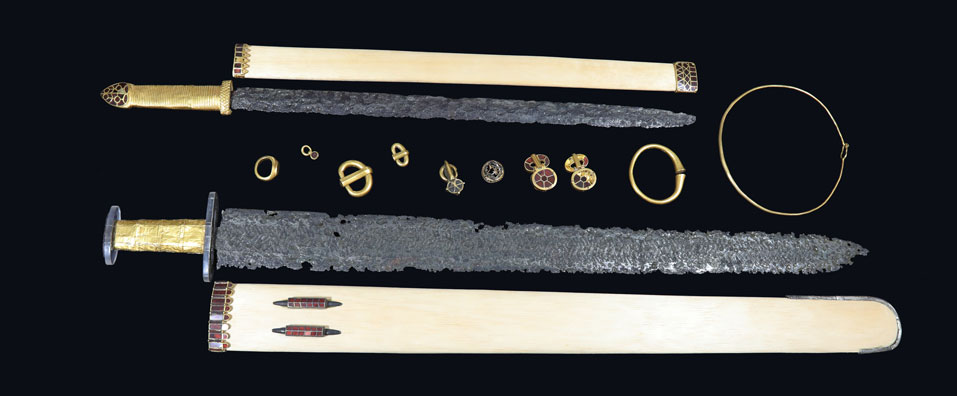
Warriors and Roman Aristocrats?
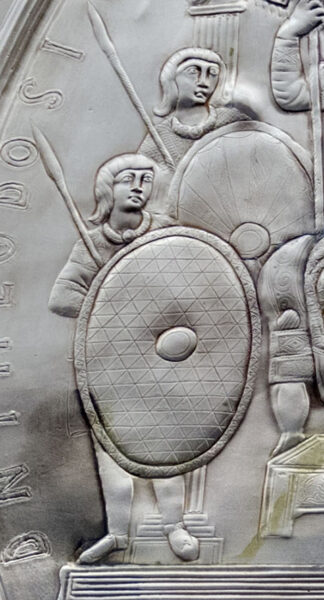
Central to this state of affairs was the need for the constant “nourishment” of the Visigothic warriors. Even if the continued attacks on Narbonne, Auvergne, and later Provence were hampered by the fortifications raised around the main cities, the sources tell of a state of continuous warfare. Kings and their warriors were made by war. Either in the beginning, when the Visigoths fought as foederati in the Roman army; or later when their kings kept his men continuously engaged on the battlefields in southern France. Any war-leader is only so much worth as the weight of the gold and loot, he can disperse among his men.
One challenge in this game was to keep up the numbers of men. Hence, any motley barbarian or Gallo-Roman who bore a balearic and sword was likely recruited to become a “Goth”. Such was especially the case later during the reign of Euric, when Ostrogoths were recruited and “ethno-ised”. It has been suggested that when the Gothic Kingdom of Toulouse collapsed at the Battle of Vouillé in AD 507, it was simply due to lack of manpower combined with the effort of the Burgundians, who succeeded in stopping the Ostrogoths coming to the aid of their “brethren”.[19]
Unfortunately, we have little information about the warrior-codex, which culturally governed these people.
At the top was a king. Such “kings” were a recognised name for a significant warlord inside the Roman hierarchy. But we know from Wulfila’s Gothic translation of the bible from the 4th century, that the Goths were ruled by a reikeis (proto-germanic: *rīkijaz); they must have felt familiar with the use of of rex in Latin. Later, in the second half of the 5th century, the designation was expanded. Thus, on the seal-ring of Alaric, we read the inscription, Rex Gothorum. It appears, it became gradually more important for the new barbarian leaders to flaunt precise titles.
Further, in the fragment of Euric’s Code from ca. 480, we hear about warlords (comes and ducis) patrons, mercenaries or private army retainers, bucellarrii, and saiones; the latter was a category of lesser retainers named with a Gothic epithet. Although “free” in a Roman sense (that is non-slaves), the two types of retainers had little claim to their own property while being part of the retinue of a patron. Leaving “his” protection, any patron had the right to demand half of the wealth belonging to a bucellarius. All, which a saio possessed, could be claimed as the property of the patron. Saiones were a kind of practical retainers, sergeants. If either of them died, the right to marry off any widows or daughters belonged to the patron[20]. Less systematically, we read in the sources about high-ranking counts, comites or duces Gothorum, who represented the king in a number of administrative or military contexts. This type of social organisation is reminiscent of the social structure revealed in a 4th-century source, The Passion of St. Saba the Goth. Saba lived in a village near the Carpathian mountains, where he was martyred in AD 372. In the text, we meet a village council and registers a village meeting of some sort. But we also encounter a Gothic leader related to the king and with a substantial “Gefolgschaft” (retinue). They carried out the actual killing.[21]
So, what were the Visigoths? An army, a people or a budding polity? The answer to that probably lies in the convoluted question of what kind of identity, it was even possible to establish during the 5th century? The answer to that may lie in the idea of what it meant to be a “Roman”. A Roman in Gaul at that time was, as has been recently argued[22] a profound “political animal”, that is a senator, a public administrator, or one of their up-and-coming minions. Such “Romans” would be formed in the rhetorical and legalistic crucible of Roman education, “paideia” and taught Roman literature and law. They would also constitute the core of the Gallo-Roman aristocracy, including those who were later employed in the service of the kings of the Goths as emissaries, bureaucrats, or military leaders.
However, as the 5thcentury progressed, these “Romans” felt less and less secure in their own world. They might still enjoy the vestiges of the old life in their villas, with their private baths and chapels, while exchanging letters with their friends and in general enjoying and sharing literature. They might even belong to select clubs of learned academics well-versed in the profound culture of Classical Antiquity. They may even have believed it was possible to civilise the new people in power.
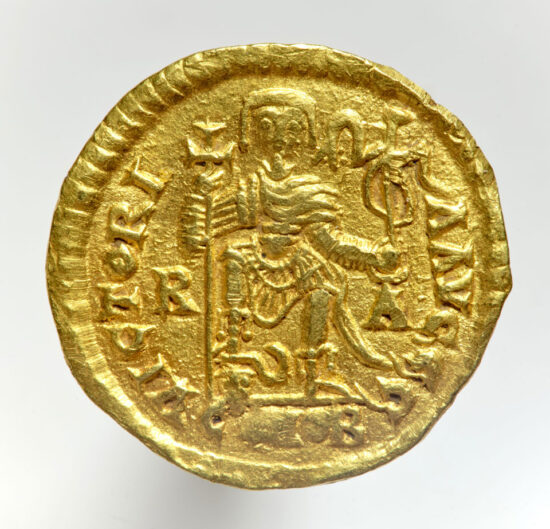
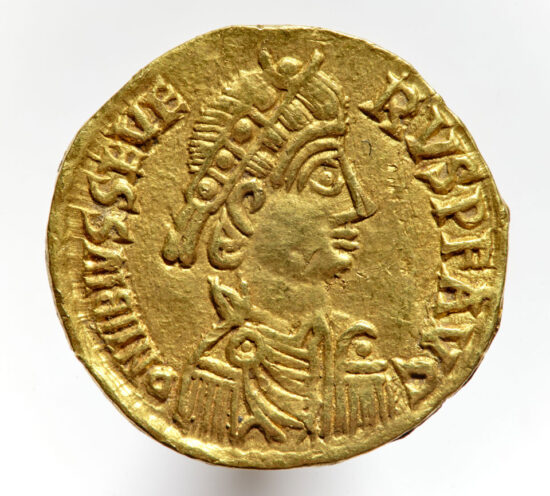
Thus, Roman education was an opportunity, which at least Theoderic II was offered. He is said to have been able to recite Vergil verbatim. In this upbringing, we must presume both his brothers, Thorismund and Euric, took part. Hence, all three must have known and spoken fluent Latin. And yet, we should remember that although Euric sponsored an entire law code in Latin, he claimed his right to negotiate at Toulouse with Roman emissaries in Gothic, having the conversation translated simultaneously into Latin. Letting the diplomats eat their own medicine, was of course a distinct emulation of imperial practice. In Rome as well as in Toulouse, the dictum held: When in Toulouse, do as the Romans…
In this connection we should note that although Euric’s Code included a number of paraphrases of Roman laws, the organisation of the text was different. Also, the final judgement arbitrarily came to reside with the king or his counts. Not the niceties of a legal set-up based on archives and witnessed deeds and donations, ruled the day. Instead, might became right.
On one point, though, the Visigothic kings in the 5thcentury did not expropriate the visible paraphernalia of their Roman counterparts. Although the minting of golden solidi did take place in Toulouse and other major cities in the new realm – at least after the 450s –, the coins continued to be careful imitations of Roman imperial coins. Even when the last West Roman Emperor was dethroned after AD 476, the minted coins continued to sport the profiles of the East Roman emperors[23]. Compared to the contemporary issues of Suevic coins, the evidence as to the location of the mints of these coins is very spurious. On silver-coins minted in Galicia by Rechiar (AD 415-456) , the reverse could be marked with the inscription “Iussu Richiari Reges”. Such was not the case at Toulouse, even though the practice must have been well-known. Apparently, there was a limit to the dare of the Visigothic kings at Toulouse. Coins were a form of political communication or media, which was not appropriated until the portraits of Clovis and Theoderic the Great, began to be engraved on their coins.
Three Barbarian Kings and their Portraits on Signet Rings
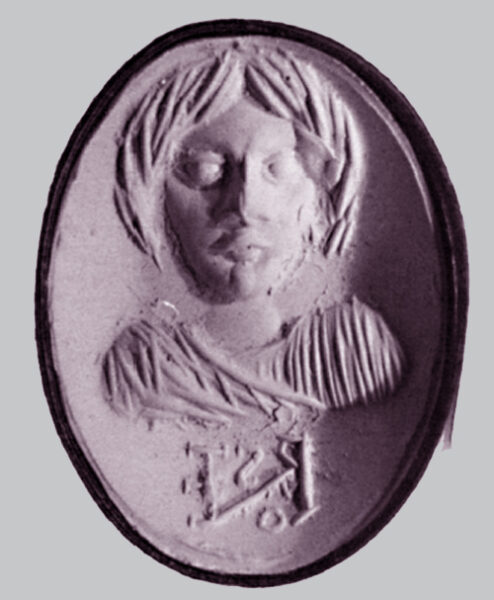
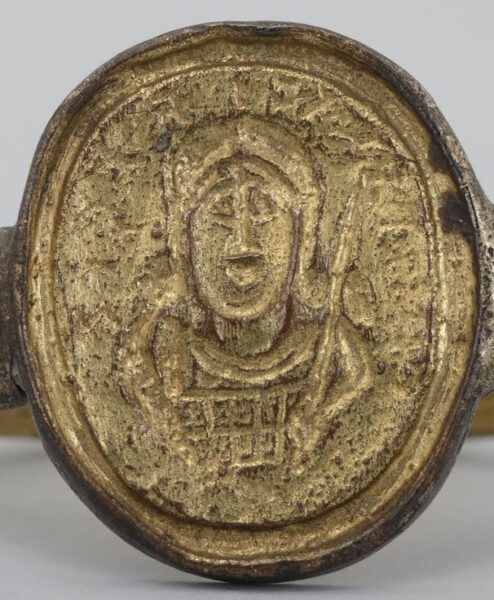
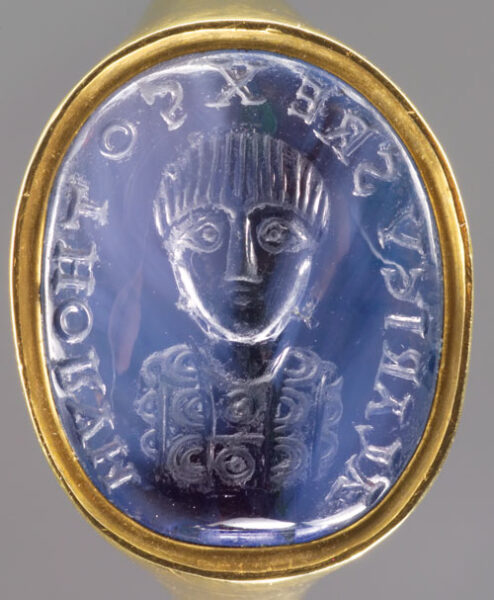
Matrimonial Alliances
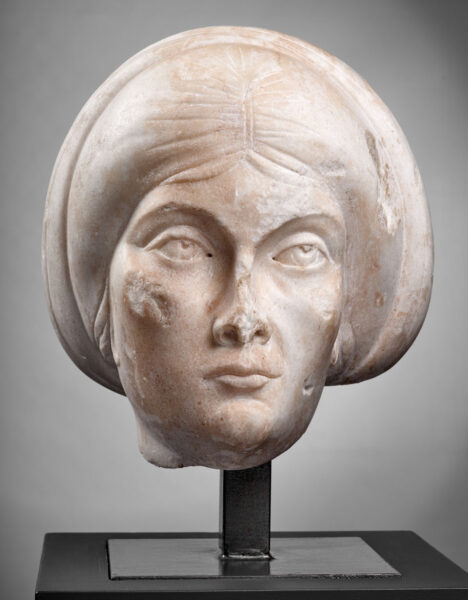
In AD 414 Athaulf married one of the Roman hostages taken during the fall of Rome in Ad 410, Galla Placidia. She was the daughter of the Roman Emperor Theodosius I and had fallen into the hands of the Goths during the siege. The marriage, which took place in Narbonne, was not only magnificent but also conducted according to Roman tradition. It was later claimed that Athaulf at the ceremony pledged to work not to destroy Rome, but rather return Rome to its former splendour. Soon after, their son died , and Athaulf was murdered in Barcelona. Following this, Galla Placidia was once again turned into a bargaining chip in the pax negotiated between Vallia and Constantius after AD 415. Apparently, this marriage was a one-off until the Roman general, Ricimer (418-472) was able to marry Alypia (see below).
We are not fully informed about the wives of the later Gothic kings. It appears, they lived with several wives and concubines, but none of those appears to have been born as Roman princesses or daughters of senatorial aristocrats. Rather, the matrimonial networks, which Jordanes informs us about, must be characterised as Barbaric. Thus, the Sueve, Rechila († 448) married a daughter of the Visigoth, Vallia. Their son Rechiar (AD 415-456), married a daughter of Theoderic I, who was married to a (half?)sister of Rechiar’s, Valliana (or Flavia). Rechiar, was thus married to a sister to Theoderic II, Thorismund, and Euric. Of their wives, not much is known.
However, we are quite well informed about the next generation. First there is Ricimer, a son or nephew of the Suevic king. Ricimer fulfilled the role of the Roman magister militum of Western Europe. De facto, he ruled the Western Empire between AD 461 – 472. As said above, he married Alypia of Rome, daughter of Anthemius, one of the very late Western emperors. She was the granddaughter of the Eastern Roman Emperor, Marcian. However, the sister of Ricimer married Gundioc, King of the Burgundians († AD 473).
Finally, Jordanes[24]tells us, Alaric II married Theodegotha, the daughter of the Ostrogoth Theoderic the Great, while her sister, Ostrogotha, married the Burgundian king Sigismund. Yet, a third daughter was married off to the Vandal king in North Africa, while a niece was married to Hermanfrid, king of the Thuringians. All three daughters were apparently children of an earlier wife of Theoderic’s, as he at about the same time married a sister to Clovis , who on his hand married Clotilde, the daughter of an earlier Burgundian king. One of their daughters was later married to a Visigothic king in Spain, patching up the events in AD 507 (see below).
As can be seen from this list, the matrimonial network of the rulers of the barbarian successor-kingdoms must have been acutely aware of the value of creating alliances with their contemporaries. Apart from Ricimer, who went native as a Roman, they all appear to have focused on forging their own political network between the successor-kingdoms in the 5thand 6thcenturies.
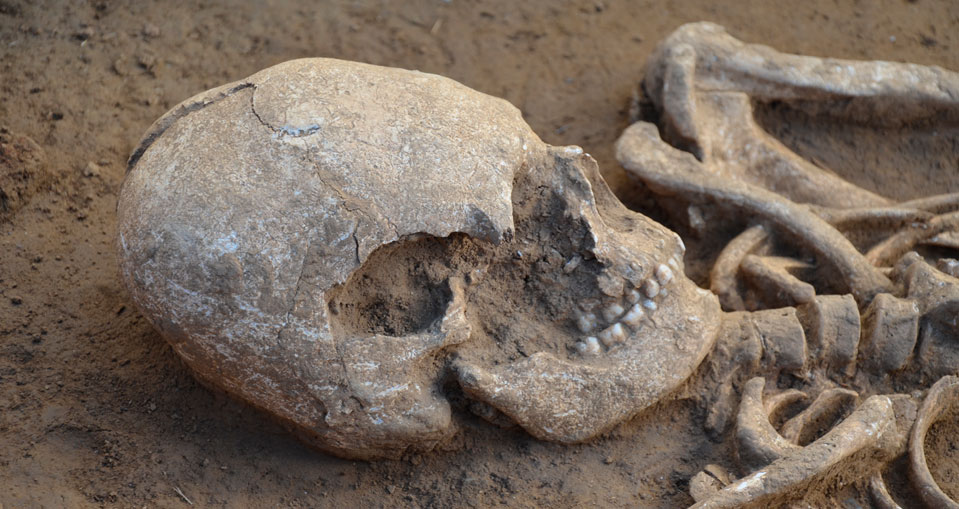
Political Networks and Religion
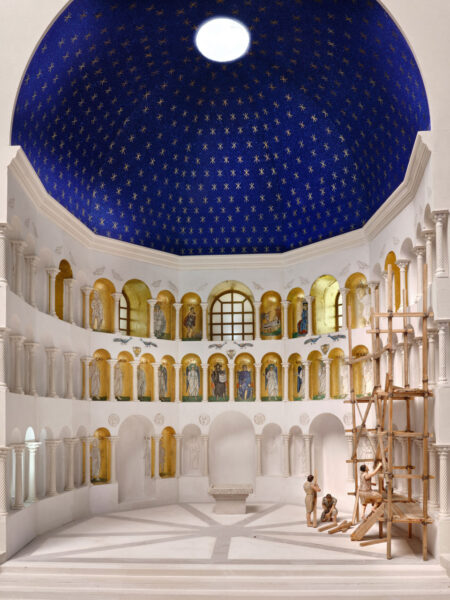
The extensive letter collections preserved from Late Antiquity provide us with a vivid sense of what it took to culturally negotiate the Gothic presence in Gaul in the 5thcentury. “Aristocrats who played their cards right were able to survive the storm”, writes Ralph Mathiesen in his book-length study on the Roman Aristocrats in Barbarian Gaul[25].
And yet, the letters also tell us how difficult it might be to avoid being listed in the black books of either party. Thus, a weighty consideration was whether or not to participate in the respective dinners of the two cultural groupings.
One incident from AD 453 – 466, a bishop, Vivianus of Saintes, was invited to sup with Theoderic II. At his table, Vivianus was asked to share a cup with the Arian bishops who were fellow guests. Declining the offer for religious reasons, the King was offended, and Vivianus was imprisoned for his insult. Somewhat later, in AD 474, bishop Epihanius of Pavia deftly avoided the same fate by claiming “he was not accustomed to eating out and also, that he wanted to get an early start to return home”.
However, the opposite was also be the case. Thus, in AD 453, a church council in Angers stated that “If anyone is apprehended having been involved in the betrayal or capture of cities, let him not only be excluded from communion, let him also be excluded from dinner parties”. Obviously, breaking bread with the right people was considered important; the right people being those subscribing to the right understanding of the nature of Jesus and Christ.
It appears, one of the paramount distinctions between the Gallo-Romans and their counterpart, the Goths deserves a remark. While the Gallo-Romans were Nicene Catholics, the Goths were Arians. We may ponder what difference any understanding of the exact relationship between God and Jesus might make. Were God the Father and Jesus on par? Or was Jesus begotten and subordinate to the Godhead? In what sense did these questions matter?
The majority of historians will claim that such doctrinal disputes had less impact than the form of church organisation and any episcopal influence, which might be derived from belonging to either “club”. Superficially, it does indeed look like this.
Thus, in AD 470 the Gallo-Roman grandee and bishop at Clermont, Sidonius Appolinaris travelled to Bourges to oversee the election of a new bishop. With a typical Roman flair for an orderly process, Sidonius called on favours from a number of his fellow bishops to lend the proceedings gravitas, while at the same time invoking his idea of strong leadership. During this process, Sidonius elected Simplicius as his favourite candidate. Not because Simplicius was pious, nor because he was concerned with status, but rather, because he was an experienced negotiator between Romans and Barbarians. In short, Simplicius was a honoratus, a Gallo-Roman aristocrat as was Sidonius; and therefore the best choice of them all. Soon after the election, though, the same Simplicius was sent in exile by the king of the Goths.
In one of his letters Sidonius afterwards describes with venom, what they were up against, namely “the actions of Euric, the Gothic King, who is breaking and bearing down an ancient treaty to defend – or rather extend – by armed force the frontiers of his kingdom”. About Euric, Sidonius further writes: “I must confess that as formidable as the mighty Goth may be, I dread him less as the assailant of our [city]walls than as the subverter of our Christian laws. They say that the mere mention of the word “Catholic” so embitters his countenance and heart, that one might take him for the chief priest of his Arian sect, rather than for the king of his nation. Omnipotent in arms, keen-witted, and in the full vigour of life, he yet makes this single mistake – he attributes his success in his design and enterprises to the orthodoxy of his belief, whereas the real cause lies in mere earthly fortune”.
From there, Sidonius went on to describe the pitiful circumstances of his flock as they apparently reflected the lack of public support or even harassment by the Goths: “Diocese and parish lie waste without ministers. You may see the rotten roofs of churches fallen in, the doors unhinged and blocked by growing brambles. More grievous still, you may see the cattle not only lying in the half-ruined porticoes but grazing beside altars green with weeds. And this desolation is not only found in country parishes; even the congregations of urban churches begin to fall away”.[26]
The Crucible of Feudalism?
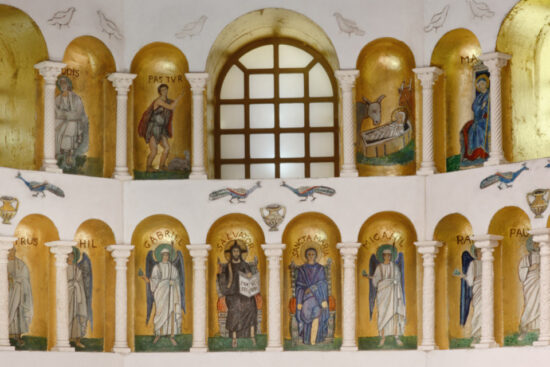
It is a bleak picture, Sidonius painted of a world gone awry. Whatever the reality behind this apocalyptic and ruined landscape, we do get a vivid picture of the cultural devastation, to which he bore witness in his letters. Likely, the vignette with the ruined churches should be read as a counterbalance to his description in another letter of his very Roman villa at Aviaticum, which was confiscated at the same time as he wrote his dispirited letter with its harsh attack on Euric.
It may seem as if the cities in the 6thcentury turned into near ghost-towns with their crumbling walls and their downtrodden fora, while the bishops took refuge in their palaces next to the new cathedrals. It may also seem as if the countryside became ravaged by widespread desolation and feuding, while the leaders were reduced to more or less petty and warring kings.
But more was obviously at stake here than just the “decline and fall” of the world, which Sidonius had known and loved. Perhaps, the deep-seated controversy between the two Christological ways of thinking engendered a social landscape, which became the crucible of the medieval world?[27]Looking closer, two different social and organisational principles came into play.
On one hand were the Gothic warlords, who settled in the countryside and built a proto-feudal society on estates divided up into the ruins of the villas surrounded by self-sufficient farms (which in time came to constitute villages). On the other hand were the Gallo-Roman aristocrats gradually robbed of their landed estates and entrenched in their cities with their episcopal palaces. While autocratic warlords ruled in the countryside, Roman law and not least the ingrained civil practices continued to rule in the cities.
To these different social forms correspond the two dogmas about the status of Jesus, the Arian and the catholic. On one hand – in Toulouse and in the countryside – Jesus was subordinated to the Godhead in the same manner as the king’s counts, their retainers, wives and children were positioned in an orderly and layered hierarchy as described by Euric’s code. On the other hand, the “civilised” cities with their carefully balanced “Trinitarian” organisation ruled by law, order and church set up a balanced and politically “disputational” set of ideas.
Perhaps, the main point of the controversy between the Catholics and the Arians was the same as the present-day controversy between Catholics and Lutherans? Which has all to do with the status of the clerisy, and the organisational principles of the various churches; and only superficially touches upon dogmatic questions, the role of which is merely to underwrite the respective social organisational forms. On the other hand, the dogmatics of the Arians and the Nicesnes did reflect the doxai of the two worlds. The question deserves a more thorough study.
The Battle of Voullé AD 507
“The affinities of kings ought to keep their subjects from the plague of war. We are grieved to hear of the paltry causes which are giving rise to rumours of war between you and our son Alaric, rumours which gladden the hearts of the enemies of both of you. Let me say with all frankness, but with all affection, just what I think: “It is the act of a passionate man to get his troops ready for action at the first embassy which he sends.” Instead of that refer the matter to our arbitration. It would be a delight to me to choose men capable of mediating between you. What would you yourselves think of me if I could hear unmoved of your murderous intentions towards one another? Away with this conflict, in which one of you will probably be utterly destroyed. Throw away the sword which you wield for my humiliation. By what right do I thus threaten you? By the right of a father and a friend. He who shall despise this advice of ours will have to reckon us and our friends as his adversaries. ‘I send two ambassadors to you, as I have to my son Alaric, and hope that they may be able so to arrange matters that no alien malignity may sow the seeds of dissension between you, and that your nations, which under your fathers have long enjoyed the blessings of peace, may not now be laid waste by sudden collision. You ought to believe him who, as you know, has rejoiced in your prosperity. No true friend is he who launches his associates, unwarned, into the headlong dangers of war.” (Theoderic the Great to Clovis in AD 506. From: Cassiodorus, Variae Book 3.1)[28].
In AD 507, The Visigothic Kingdom in Toulouse ended. Despite the numerous entreaties and letters of Theoderic the Great, the Frankish (Catholic) king, Clovis, invaded Aquitaine and waged war against Alaric II and the Visigoths of Toulouse. For various reasons, the Ostrogoths did not arrive in time to protect their Arian brethren, and Alaric II died on the battlefield at Vouillé together with (among multiple others) Sidonius’ son, who led a contingent of soldiers; afterwards Toulouse was looted, and the Visigoths retracted to the west and south, to later establish the centre of their kingdom in Iberia.
But the Visigoths in Toulouse left their mark on the language of southern France, the langue d’oc, as well as on the social structure of Medieval Europe with its nations, cities and country-sides; as well as its recurring implosions and explosions into empires, nations, city-states and feudal castellanies.
Karen Schousboe
FEATURED PHOTO:
Reconstruction of the Visigothic palace in Toulouse © Musée de Saint-Raymond/Christian Darles
NOTES
[1]Retracing the Goths. By Jan Poul StridIn: Wulfila 311-2011. International Symposium. Uppsala University June 15-18, 2011. Ed. By Anders Kaliff and Lars Munkhammar. Series: Acta Bibliohecae R. Universitatis Upsaliensis, Vol. XLVIII, p. 41 – 54.
[2]Goternas Historia. By Ingmar Stenroth. Citytidningen 2015, p. 48
[3]Claudius Claudianus: In Eutropium, AD 399. From Loeb Classical Library No. 135-36, Harvard University Press 1922, v.154-155)
[4]Gothorum relquas gentes – Liber XXX, III. From: Ammianus Marcellinus: Roman History, Volume III, Books 27-31. Excerpta Valesiana (Loeb Classical Library No. 331)
[5]Some Observations Regarding Barbarian Military demography: Geiseric’s Census of 429 and Its Implications. By Bernard S. Bachrach. In: Journal of Medieval Military History, Vol XII (2014), pp. 1-39. The arguments of Bachrach seem to carry the day.
[6]Medieval Europe. By Chris Wickham. Yale University Press 2016, p. 23 ff.
[7]Barbarians and Romans, The Techniques of Accomodation, By Walter Goffart. Toronto University Press 1980
[8]Quote from: Migration. By Peter Heather. In Networks and Neighbours. Vol 3.1 (2015), pp 1-21.
[9]Barbarian Tides: The Migration Age and the Later Roman Empire by Walter Goffart. University of Pennsylvania Press 2006. Review by: Walter Pohl in: The American Historical ReviewVol. 112, No. 3 (Jun., 2007), pp. 912-913
[10]Prosper, Chron. 1271: Constantius partricius pacem firmat cum Vallia data ei ad inhabitandum secunda Aquitanica. (The Patrician Constantius made peace with Vallia and gave him Second Aquitania to settle in).
[11]Hydatius: A Late Roman Chronicler in Post-Roman Spain : an Historiographical Study and New Critical Edition of the Chronicle. Chronica subdita Hydatii Limici, episcopi Gallaeci. By R. W. Burgess. Claerendon Press, 1993. Chron. 24.61.
[12]On Foederati, Hospitalitas, and the settlement of the Goths in A.D. 418. By Hagith Sivan. In: American Journal of Philology vol 108 (1987) pp 759-772, p 720. It is worth noting that Walter Goffart in his later book on “Barbarian Tides” (University of Pennsylvania Press 2010)did not worthy the work of Hagith Sivan so much as a footnote. See also the article by Geoffrey D. Dunn: Flavis Constantius, Galla Placidia, and the Aquitanisan Settlement of the Goths. In Phoenix, Vol. 69, n. 3-4 (2015), pp.376-393
[13]As found in Sidonius, who in AD 470 spoke of a limes sortis Gothicae. See: Forging a New Identity: The Kingdom of Toulouse and the Frontiers of Visigothic Aquitania (418-507). By Ralph W. Mathisen and Hagith S. Sivan. In: The Visigoths. Studies in Culture and Society. Ed. BY Alberto ferreiro. Brill 1999, pp. 25
[14]Roman Law and Barbarian Identity in the Late Roman West. By John Matthews. In Roman Perspectives. Studies in Political and Cultural History, from the First to the Fifth Century. By John Matthews. Bloomsbury 2010. But see also: Hospitalitas: Barbarian Settlements and Constitutional Foundations of Medieval Europe, By Andrew T Young. In: Journal of Institutional Economics. Vol. 14, No4. (2018), pp.715-737.
[15]Recruits and Veterans. By Gabriele Wesch-Klein. In: A Companion to the Roman Army. By. Ed. by Paul Erdkamp. John Wiley and Sons, 2011, p. 445
[16]Souvenirs wisigothiques dans la toponymie de la Gaule méridionale. By Pierre-Henri Billy. In : L’Europe Héritière de l’Espagne Wisgothiques. Ed. By Jacques Fontaine and Christine Pellistrandi. Madrid: Casa de Velázquez, 1992
[17]For a discussion and presentation, see Settlement of the Visigoths in the Fifth Century. By Ana Maria Jiménez Garnica. In: The Visigoths from the Migration Period to the Seventh Century: An Ethnographic Perspective. Ed. by Peter Heather, Boyles and Brewer 1999.
[18]East Germani and Alano-Sarmatian Finds of the Early Migration Period in the Roman West. By Michel Kazanski et al. In: The Migration Period between the Oder and the Vistula. Ed. by Aleksander Bursche et al. Brill 2020, pp. 832-852
[19]Forging a New Identity: The Kingdom of Toulouse and the frontiers of Visigothic Aquitania (418-507). By Ralph W. Mathisen and Hagith S. Sivan. Op. Cit., pp. 1-33
[20]Not the Theodosian Code: Euric’s Law and Late Fifth-Century Gaul. By Jill Harries. In: Society and Culture in Late Antique Gaul: Revisiting the Sources. Ed. by Ralph Mathisen and Danuta Shanzer. Routledge 2017.
[21] The Goths in the Fourth century. By Peter Heather and John Matthews. Liverpool University Press 2004, pp. 102-110
[22]“Roman Identity” in Late Antiquity, with special attention to Gaul. By Ralph W. Mathiesen. In: Transformations of Romaness. Ed. by Walther Pohl, Clemens Gantner, Cinzia Grifoni and Mariann Pollheimer-Mohaupt. De Gruyter 2018.
[23]Minting, State, and Economy in the Visgothic Kingdom: From Settlement in Aquitaine through the First Decade of the Muslim Conquest of Spain. Amsterdan University Press, 2020., pp. 25-79
[24]Jordanes: Getica, LVII-LVIII. See also: Roman-Barnbarian Marriages in the Late Empire. By R. C. Blockley. In Florilegium vol.4 (1982), pp. 63-79
[25]Roman Aristocrats in Barbarian Gaul: Strategies for Survival in an Age of Transition. By Ralph Mathisen. University of Texas Press 1993. The following examples of dinners gone awry derive from this work.
[26]The Letters of Sidonius. By Sidonius Apollinaris. Ed. and translated by Ormonde Maddock Dalton, Clarendon press 1915. Book VII, letter VI. p 109
[27]For a slightly different understanding, see Hospitalitas: Barbarian settlements and constitutional foundations of Medieval Europe. By Andrew T. Young. In: Journal of Institutional Economics, Vol 14, no 4 (2018) pp. 715-737. See also: Ricimer’s Church in Rome: How an Arian Barbarian Prospered in a Nicene World. By Ralph Mathiesen. In N. Lenski, A. Cain, eds., The Power of Religion in Late Antiquity. Ashgate 2009, pp. 307-326
[28] Cassiodori Senatoris Variae. Ed. by Theodor Mommsen. Monumenta Germaniae Historica, Auctorum Antiquissimorum Tomus XII, Berlin, Weidmann, 1894. Translation by Thomas Hodgkin.
Postscript:
Recently, Ralph W. Mathisen has demonstrated the amount of “Roman Agri Deserti”, that is state- or imperial land, which was available for the new settlers
Changing Times: The Allocation of Land to Barbarian Settlers in the Late Roman World. By Ralph W. Mathisen. In: The European Countryside during the Migration Period. Patterns of Change from Iberia to the Caucasus (300–700 CE)
Edited by Irene Bavuso and Angelo Castrorao Barba
De Gruyter 2023
READ ALSO:
